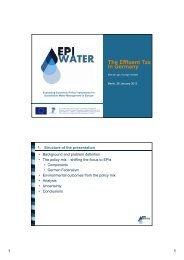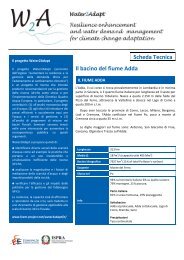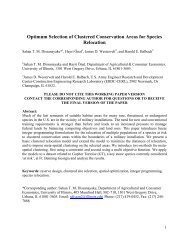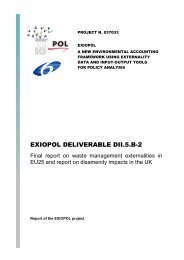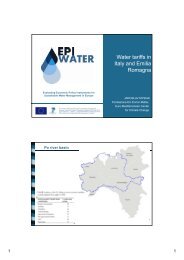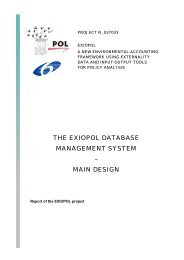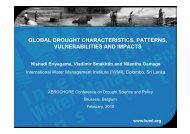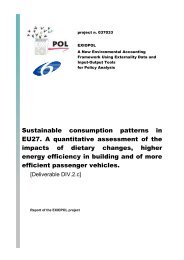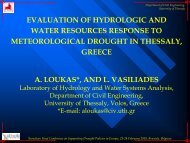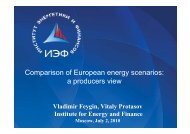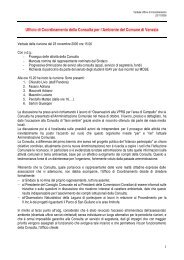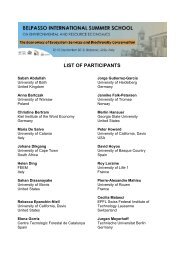Gulf and European Energy Supply Security - Feem-project.net
Gulf and European Energy Supply Security - Feem-project.net
Gulf and European Energy Supply Security - Feem-project.net
You also want an ePaper? Increase the reach of your titles
YUMPU automatically turns print PDFs into web optimized ePapers that Google loves.
<strong>Energy</strong> <strong>Security</strong>: Potential for EU-GCC Cooperation<br />
scenarios to cause significant damage <strong>and</strong> lasting<br />
impacts. Terrorists prefer to attack soft targets that<br />
are more vulnerable <strong>and</strong> may cause a larger number<br />
of fatalities.<br />
9. the Dem<strong>and</strong> Dimension of energy<br />
security<br />
In general, the promotion of a greater end-use<br />
energy efficiency should hold the first place in any<br />
energy policy, since most actions in this field have a<br />
“negative” cost, therefore they are more economically<br />
efficient than actions to support RES development<br />
<strong>and</strong> to reduce CO2 emissions (such as Carbon Capture<br />
<strong>and</strong> Storage technologies). Dem<strong>and</strong> Response<br />
should be encouraged, with a rapid <strong>and</strong> extensive<br />
deployment of enabling technologies, such as smart<br />
metering. Moreover, Dem<strong>and</strong> Response programs<br />
should be designed so as to provide strong (i.e. able<br />
to ensure a substantial economic convenience in<br />
case of response) signals, as well as be simple <strong>and</strong><br />
easily underst<strong>and</strong>able by consumers.<br />
SECURE’s analysis of the relationship between<br />
energy efficiency <strong>and</strong> energy security, has shown<br />
that energy efficiency policies in the EU do work, but<br />
there is no silver bullet able to successfully address<br />
different policy objectives such as energy security<br />
<strong>and</strong> energy efficiency, unless it is so general that it<br />
naturally encompass different sectors <strong>and</strong> energy<br />
uses.<br />
What seems to work is the policy mix: the good<br />
news is that currently in Western Europe a policy<br />
menu is in place that has produced significant<br />
improvements in energy efficiency, has reduced<br />
the amount of carbon emissions generated by the<br />
economic system, <strong>and</strong> has contributed to a more<br />
secure energy supply for Europe. On the other h<strong>and</strong>,<br />
more fine-tuning <strong>and</strong> coordination among member<br />
states is required in order to reap the potential<br />
benefits of enhanced energy efficiency also in<br />
terms of energy security. In this sense, the 20-20-20<br />
strategy <strong>and</strong>, in general, the proactive attitude of<br />
the EU in the field of climate change policy could be<br />
important opportunities.<br />
This suggests that it would be advisable to<br />
continue EU Action Plans <strong>and</strong> make them binding<br />
wherever effective. In this process, differences<br />
122<br />
in the responsiveness of energy consuming<br />
sectors to efficiency policies should be taken into<br />
account: SECURE’s analysis has highlighted, for<br />
instance, that m<strong>and</strong>atory st<strong>and</strong>ards for electrical<br />
appliances seem to work better for the residential<br />
sector, whereas measures supporting information,<br />
education <strong>and</strong> training are more effective in the<br />
industrial sector.<br />
Cross-cutting measures, in particular those<br />
related to market-based instruments, are those<br />
having the strongest influence both on energy<br />
security <strong>and</strong> energy efficiency. From this perspective,<br />
it is recommended to consider the development of<br />
white certificate market models at EU level. Due<br />
account should be taken of successful deployment<br />
in some member states.<br />
Dem<strong>and</strong> Response is profitable only if electricity<br />
markets are structurally subject to variations,<br />
which can be absorbed by the flexibility offered by<br />
customers. There are no pre-defined solutions as<br />
these hinge on structural conditions. Market design<br />
is crucial as it should exploit all the potential of DR;<br />
restrictions in flexibility should be clearly analyzed<br />
<strong>and</strong> not discarded for the sake of simplicity.<br />
Network regulation also has an important role,<br />
both at the transmission <strong>and</strong> the distribution level,<br />
<strong>and</strong>, in particular, where there is the interaction with<br />
the majority of customers <strong>and</strong> where a future large<br />
deployment of Distributed Generation is possible,<br />
which shares a very similar customer base with DR.<br />
Metering, that is, the ability to control <strong>and</strong> give<br />
detailed measures of electricity flows, is the key<br />
driver for the implementation of DR.<br />
The role of a public intervention aimed at curbing<br />
structural inefficiencies should be evaluated, not<br />
only in terms of financial support, but also in terms of<br />
creating a market with a clear <strong>and</strong> stable regulatory<br />
framework, in which Europe-wide st<strong>and</strong>ardization<br />
will reduce the costs of adaptation to national<br />
markets.<br />
10. Conclusions<br />
<strong>Security</strong> of supply should be addressed only<br />
within a wider, consistent approach that integrates<br />
the other two fundamental pillars of the EU<br />
energy policy: sustainability <strong>and</strong> competitiveness.




